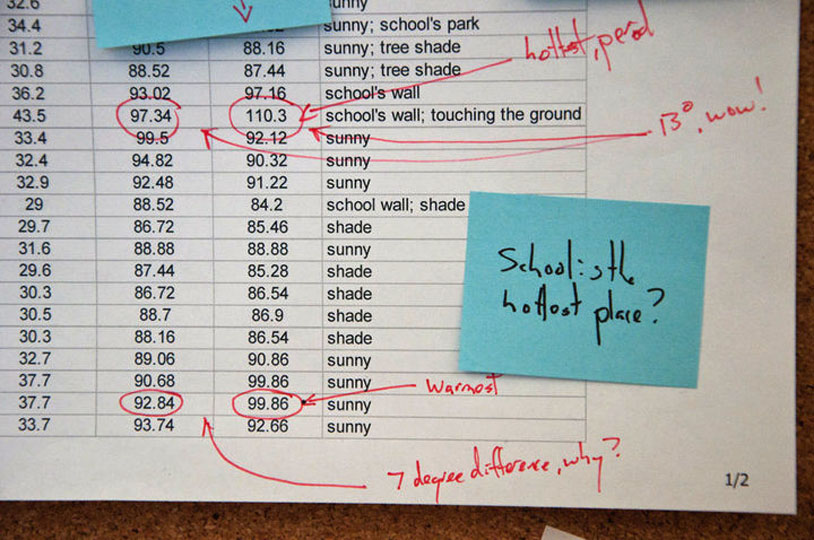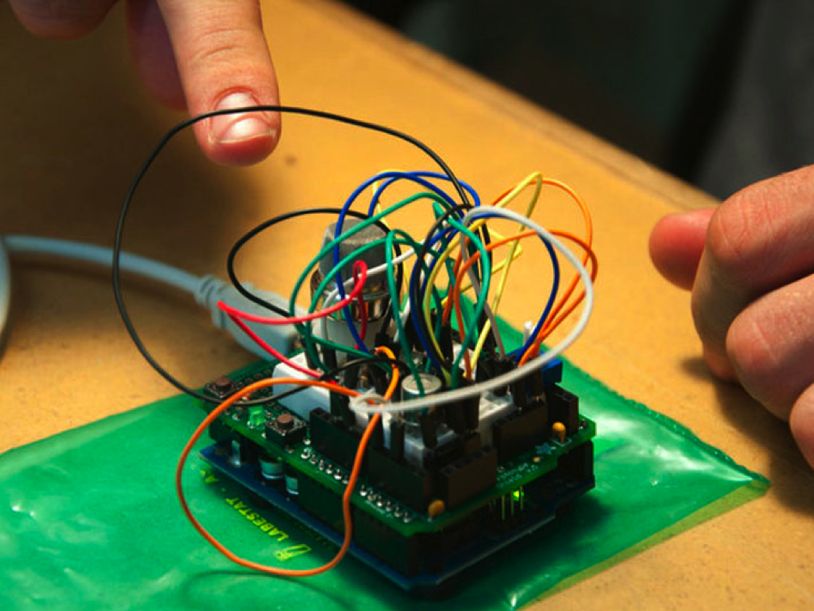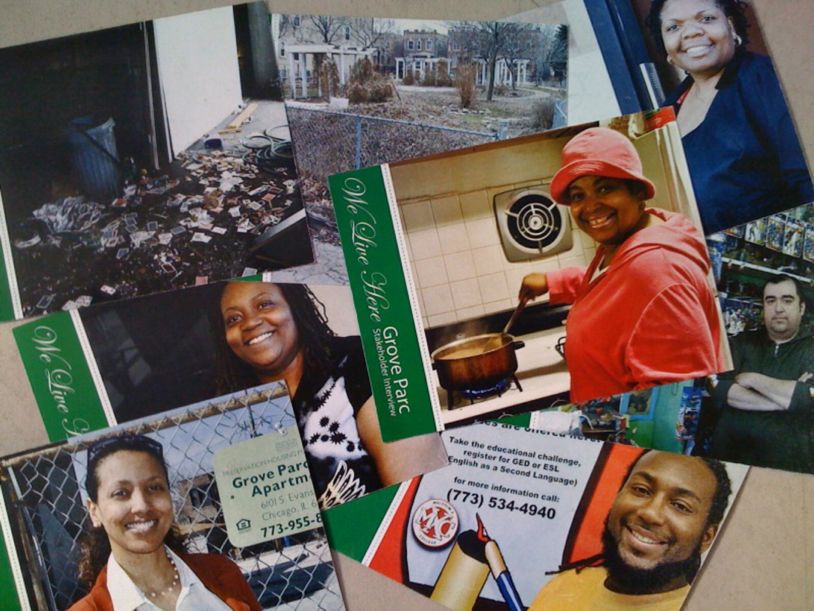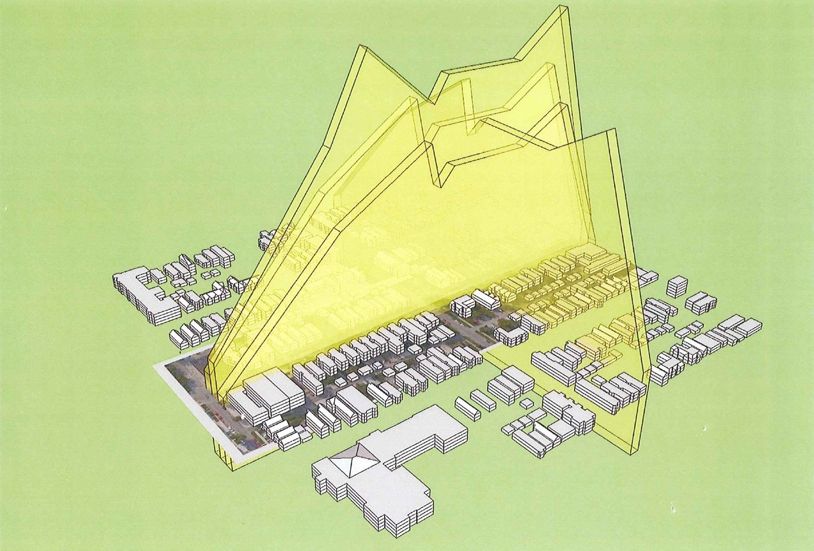
Project: Shadelab
Location: Chicago
Project Director: Alex Gilliam and Catherine Baker of Landon Bone Baker Architects
Year: Spring 2010 to Present
Young adults dressed in lab coats using oversized thermometers to find heat islands in their neighborhoods? Homemade Arduino sensors crafted to measure air quality in and around affordable housing? A two foot nose, sculpted to make the process of measuring air quality more evident to community members? Talented teens gathering stories behind the way a neighborhood and its buildings function, correlating this with sensor data to help architects, policy makers and affordable housing developers do a better job?
Shadelab is a unique, community design leadership program in which talented young Chicago adults gather data and stories to document the ‘wellness’ of the neighborhood, and communicate this information back to the community leaders, designers, and city officials to initiate positive change and improve the health, well-being and efficiency of the neighborhood through design.
‘We gather data and stories that help communities, organizations and city leaders make better decisions about how they can improve the health, well-being and efficiency of their neighborhoods through design.’
Using high tech sensors as well as self-made measuring devices, the interns extensively recording such things as temperature, air quality, energy efficiency and noise throughout the neighborhood and its buildings over the course of the summer. By overlaying this data with the mapping of the physical assets, nature, social life and stories that surrounds these spaces, interns work to create a holistic ‘snapshot’ of the neighborhood as it relates to design. With this information, the interns begin to identify improvements to the design of the communities’ structures and public space for improving energy efficiency, comfort and sociability.
Unlike traditional community asset mapping projects, teen neighborhood design investigation programs or green design education classes, where data is often gathered purely for the edification of the participants, Shadelab places the young adults in the midst of community organizations and designers who will ultimately use the information. The program is rooted in the philosophy that youth excel when they are integrated into the work of professionals, and are given a high degree of responsibility and the opportunity for their work to add real value to the world around them. For Shadelab, we start not with a list of things we would like the interns to learn, but a celebration of their existing skills, ideas, and energy and an understanding of how their work might positively contribute to the design process of the firm, it’s community partners and the neighborhood. In this way, an intern such as Neli, who grew up in the neighborhood and has a deep interest in environmental science and a personal connection to the area, is able to contribute a unique body of knowledge about the ecology of her neighborhood to a design process while at the same time meaningfully learn about architecture, urban planning and policy directly from the experts.
A further example is Brenda, another talented intern who is also from the area and knows it better than most. Thus when empowered and trained to do so, Brenda can point out complex design-related social patterns that many overlook. Her exemplary photography skills, incredible gift for gab and fluency in Spanish also mean that she can gather stories and post-occupancy evaluations that others simply can’t do.
Simultaneously, Brenda hears directly from residents the impact of design decisions made by architects and planners on their lives. In these ways, the interns not only bring unique skills to the table but also serve as important cultural translators and bridges to the community, while gaining real skills to be better designers but perhaps more importantly, design-fluent citizens. The program is further strengthened and these connections are reinforced by weekly ‘Smartlucks’–potluck design charettes–with designers, local experts and community leaders.
Created out of a partnership between a local architecture firm, Landon Bone Baker Associates (LBBA); Public Workshop and Latin United Community Housing Association (LUCHA), an affordable housing developer and property manager; Shadelab was launched in the summer of 2010, locating readily available job-to-work funds to assemble a team of six young adults age 16 through 26. The team focused on a few blocks in the Humboldt Park neighborhood where a majority of LUCHA’s rental buildings are concentrated. LBBA sponsored and hosted the program, using their office as headquarters.
Well known as longtime designers and builders of affordable housing in Chicago, this project grew out of LBBA and LUCHA’s desire to have a greater impact than they have been able to affect through buildings alone. Of particular interest to the firm and their community partners were questions such as:
How efficiently are their buildings functioning and where could improvements be made? How are the clients using them relative to their design? Are the ‘green’ materials they chose positively impacting their clients’ well-being? Are there heat islands in the neighborhood? Is code negatively impacting the energy efficiency of their buildings? How can we grow green jobs and skilled leaders in the neighborhood?
Having created innovative design programs for communities and institutions across the country, Public Workshop was brought on to help design Shadelab, form additional organizational partnerships and lead the program.
Want to learn more about the project? Make sure you stop by the Shadelab website: shadelab.landonbonebaker.com
Shadelab would not be possible without the tremendous support of the following organizations:
Sensaris
Chicago Architecture Foundation
Chicago Public Schools
Latin United Community Housing Association
Marwen
Metropolitan Chicago Information Center
And people:
Jim Cavallo, Kouba-Cavallo Associates
Paul Domagala, Argonne National Laboratories
Shannon Downey, Pivotal Chicago
Roberta Feldman, City Design Center at the University of Illinois-Chicago
Alexandra Guilamo, Principal of Von Humboldt Elementary School
Dawn Hancock, Firebelly Design
Yamani Hernandez, Chicago Public Schools
Erin Koch
Karen Kranz
Alderman Maldonado, 26th Ward Chicago Alderman
Justin Massa, Metropolitan Chicago Information Center
Eric Michaud, Argonne National Laboratory
Scott Mehaffey, City of Chicago Department of Environment: Natural Resources & Water Quality Division
Eric Michaud, Argonne National Laboratories
Joey Nakayama, Project H- Chicago
Krisann Rehbein, Chicago Architecture Foundation
Michael Setton, Sensaris
Suzi Sosa, MPower Labs
John Tolva, IBM: City Forward
Jeff Warren, Grassroots Mapping






Posted on January 18th, 2011 at 8:34 am by publicworkshop in Our Work